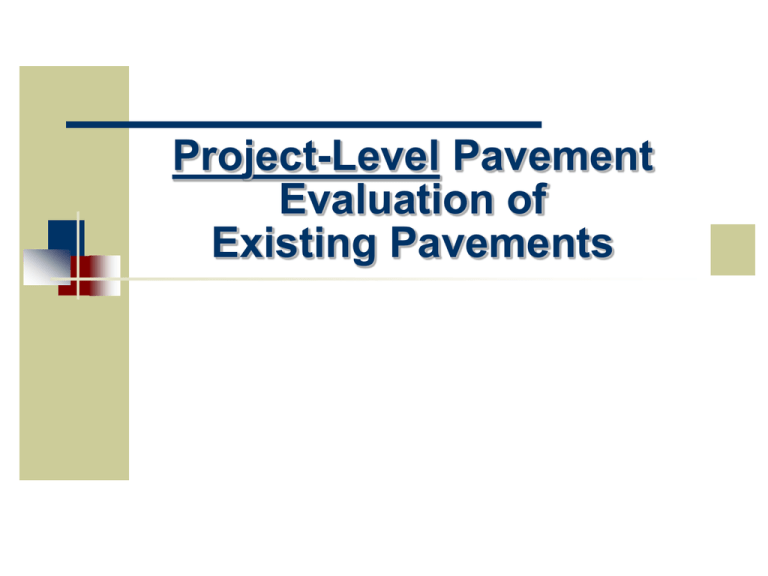Pavement Eval
advertisement

Project-Level Pavement Evaluation of Existing Pavements Class Objectives Describe data required for project-level evaluation of existing pavements Determine AC and PCC pavement layer properties General Project-Level Pavement Evaluation Rehabilitation design requires an evaluation of the existing pavement to provide key information Determining the extent of damage and material properties of the in-place layers is the most critical challenge in pavement evaluation Many failures of Pavement Rehabilitations are due to inadequate pavement evaluations General Project-Level Pavement Evaluation Level of Detail and Factors to Consider: Agency Level (Local, County, State) Functional Class of Roadway (local, collector, arterial) PMS Recommended Treatment Type Pavement Evaluation Cost Pavement Design Methodology General Project-Level Pavement Evaluation Consists of: Structural adequacy (Load Related) Functional adequacy (User Related) Drainage adequacy Shoulder condition Material durability Variation along project Constraints Miscellaneous (e.g., joint condition) Factors for Rehabilitation Design • Pavement has significant and extensive levels of distress that exceed the user’s failure criteria, condition of the existing pavement may be determined from results of the visual distress surveys • Pavement has exhibited no structural distress, field and laboratory testing become important to determine the condition of the existing pavement layers • Pavement has marginal levels of distress, the results from the visual distress survey may be used to determine the location and frequency of the field tests and cores Data Requirements Historical—Data collected prior to current pavement evaluation Benchmark—Data collected as part of the current pavement evaluation process Benchmark Data Is there any load-related distress? Are there areas with excessive deflections? What is the effect of lack of maintenance on pavement structural integrity? What is the amount of previous maintenance and rehabilitation work? Benchmark Data Is there a systematic variation in pavement structural condition at these locations? What are some of the potential constraints? Project-Level Evaluation Project-Level Evaluation IRI Project-Level Evaluation Project-Level Evaluation Project-Level Evaluation Project-Level Evaluation Project-Level Evaluation Field Evaluation Plan Evaluation Plan Obtain and compile historical data Preliminary data evaluation Detailed survey Evaluation Plan Second/final data evaluation Final report Documentation of results Recommendations on feasible rehabilitation alternatives MEPDG INPUTS MEPDG Inputs for Rehab Historical Data Required information: Site (e.g., traffic, environment, and subgrade) Design (e.g., layer thickness, material properties) Construction records (as built) Historical Inputs Historical Inputs Historical Inputs Historical Inputs Historical Inputs Historical Inputs Historical Inputs Historical Inputs Detailed Survey A detailed survey typically consists of: Visual distress survey Nondestructive testing (NDT), FWD including the backcalculation of layer elastic moduli Destructive testing Laboratory analysis and materials characterization All Lanes in each direction May include Shoulders Visual Distress Survey Detailed visual distress survey must be conducted to determine the amount, type and severity of load-related distress LTPP Distress Identification Manual is a good source of information for agencies with no local guidelines Automated Visual Distress Survey Automated Visual Distress Survey Right of Way Vertical Pavement View Nondestructive Testing NDT procedures consist of the following: Layer Thicknesses (GPR) FWD Deflection testing (material properties) Ground Penetrating Radar Ground Penetrating Radar Results based on antenna frequency and dampness of granular material Ground Penetrating Radar NDT-Deflection Testing Typical uses of FWD deflection data: Estimate layer modulus values for design Determine areas with excessive deflections Determine variability along project To compute LTE for JCP Void detection under PCC slabs Falling Weight Deflectometer Falling Weight Deflectometer Falling Weight Deflectometer FWD tests have the following advantages: Simulate a moving wheel load Measure pavement response-deflection basin Require no fixed reference Relatively fast FWD Sensor Configuration 12 in. 12 in. 12 in. 12 in. 12 in. 12 in. Loading Wheel Contact Area Sensor 12 in. Example of a Deflection Basin P Load plate d0 AREA d12 d36 d60 Backcalculation Software Flexible pavements BOUSDEF, EVERCALC, MODULUS, MODCOMP, and others Rigid pavements Best fit spreadsheet, AREA spreadsheet, and others Load Transfer Efficiency Load Transfer Efficiency Others Uses of Deflection Data -LTE where LTE = u = l = u LTE *100 l Target is 70% load transfer efficiency, percent deflection 6 inches from unloaded slab joint deflection 6 inches from loaded slab joint * If deflections are very small, LTE is not considered Destructive Testing Coring Equipment 4 inch Cores 6 inch Cores 12 inch Cores Core Samples Dynamic Cone Penetrometer Dynamic Cone Penetrometer 17.7 lb hammer = twice the penetration of the 10.1 lb hammer 10.1 lb for soft 17.6 lb for hard Use penetration of 17.6 lb hammer Destructive Testing—Coring and Materials Testing Subgrade resilient modulus, CBR, R-value AC layers and stabilized base Resilient modulus Asphalt stripping Degradation Erosion, bonding Layer thicknesses Destructive Testing—Coring and Materials Testing PCC Flexural strength Elastic modulus Granular base and subbase Degradation Contamination by fines Resilient modulus, CBR, R-value Layer thicknesses Sampled Material Disturbed and Undisturbed Samples Laboratory Testing Resilient Modulus Mr Ep HMA Mixtures Tests Volumetric Properties Dynamic Modulus Creep Compliance Indirect Tensile Strength Asphalt Binder Classification PCC Mixtures Tests Elastic Modulus of PCC Indirect Tensile Strength Flexural Strength Unbound Layer Material Tests Resilient Modulus – Subgrade, Subbase, and Base Volumetric Properties Soil and Aggregate Classifications Pavement Cold Milling Structural Adequacy Assessment Current structural adequacy based on Type, severity, and extent of load-related distresses In-situ material properties (coring and testing) Analysis of pavement response to loading (deflection testing) Future structural adequacy based on Remaining life Assessing Current Structural Adequacy using Distress DataFlexible (Interstate/Freeways) Distress Type Current Distress Level Regarded As: Adequate Marginal Inadequate Fatigue cracking, % of total Lane miles Longitudinal cracking (WP), ft/Mi Transverse cracks, ft/Mi <5 5-20 > 20 <265 265-1060 > 1060 <500 500-800 > 800 Rutting, inch < 0.25 0.25-0.45 > 0.45 Assessing Current Structural Adequacy using Distress DataFlexible (Primary Arterials) Distress Type Current Distress Level Regarded As: Adequate Marginal Inadequate Fatigue cracking, % of total Lane miles Longitudinal cracking (WP), ft/Mi Transverse cracks, ft/Mi <10 10-45 > 45 <530 530-2650 > 2650 <800 800-1000 > 1000 Rutting, inch < 0.35 0.35-0.60 > 0.60 Assessing Current Structural Adequacy using Distress DataFlexible (Secondary Roads) Distress Type Current Distress Level Regarded As: Adequate Marginal Inadequate Fatigue cracking, % of total Lane miles Longitudinal cracking (WP), ft/Mi Transverse cracks, ft/Mi <10 10-45 > 45 <530 530-2650 > 2650 <800 800-1000 > 1000 Rutting, inch < 0.4 0.4-0.8 > 0.80 Assessing Current Structural Adequacy using Distress Data-Rigid LoadJPCP Distress Level Regarded As: Related Highway Distress Class Inadequate Marginal Adequate Cracking Interstate >10 5 to 10 <5 Faulting Interstate >0.2 0.1 to 0.2 <0.1 Patching Interstate >10 5 to 10 <5 Assessing Current Structural Adequacy using In-situ Properties Range Mean Variable Material Type Elastic modulus, psi PCC AC 250,000 1,000,000 600,000 Base resilient modulus, psi ACtreated Lean concrete Granular 100,000 500,000 250,000 Low High 3,000,000 7,000,000 4,500,000 500,000 15,000 2,500,000 1,500,000 40,000 30,000 Shoulder Adequacy Assessment Important because shoulder condition affects pavement structural integrity and shoulders may be used as temporary lanes Use same load-related distresses to assess shoulder condition Threshold values should be lower than for the actual pavement Variability Along Project Important for optimizing rehabilitation strategy Main forms of variability that should be identified includes: Variations along project Lane-to-lane variations Intersections and bridge approaches Cut and fill sections Pavement Analysis Segments Pavement Analysis Segments Example Test Section with Uniform Deflections Graphical Review Deflection (microns) 400 350 SEN-1 300 SEN-2 250 SEN-3 200 SEN-4 150 SEN-5 100 SEN-6 50 SEN-7 0 -20 0 20 40 Stations (m) 60 80 Example Test Section with High Variability in Deflections Deflection (microns) 350 300 SEN-1 250 SEN-2 200 SEN-3 SEN-4 150 SEN-5 100 SEN-6 50 SEN-7 0 80 100 120 Stations (m) 140 160 Example Test Section with Abrupt Change in Deflections Deflection (microns) 600 SEN-1 500 SEN-2 400 SEN-3 300 SEN-4 SEN-5 200 SEN-6 100 SEN-7 0 80 100 120 140 Stations (m) 160 180 Selection of Feasible Rehabilitation Alternatives Based on current structural condition determine feasible rehabilitation options: Restoration (Preventive Maintenance) Rehabilitation without overlays (Repairs) Rehabilitation with overlays (Minor/Major) Reconstruction Other factors such as functional adequacy, drainage, etc., must be considered Project-Level Pavement Evaluation of Existing Pavements QUESTIONS?








